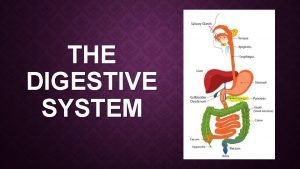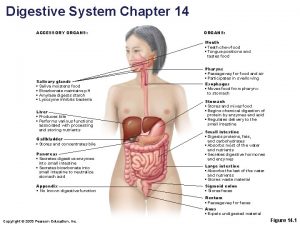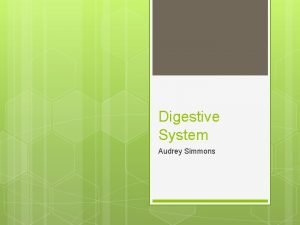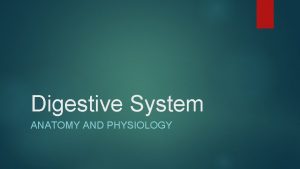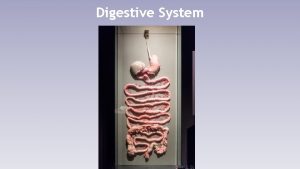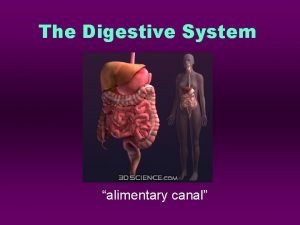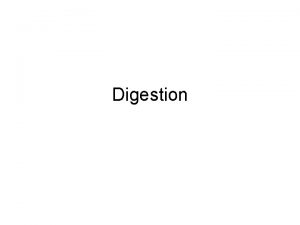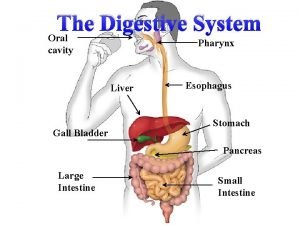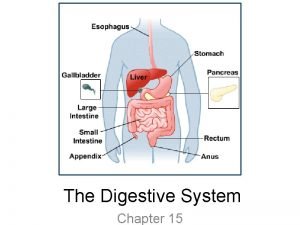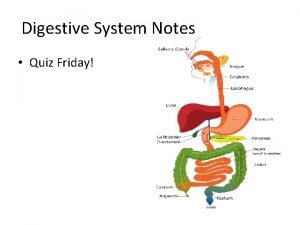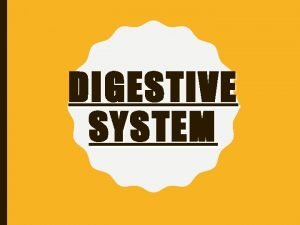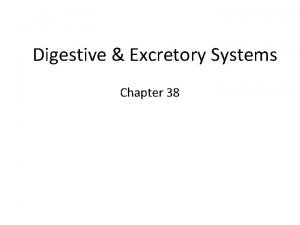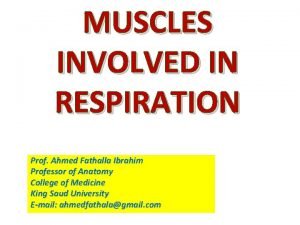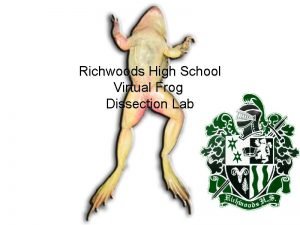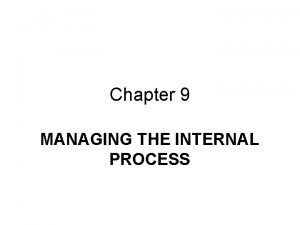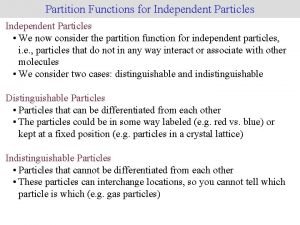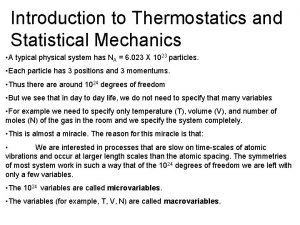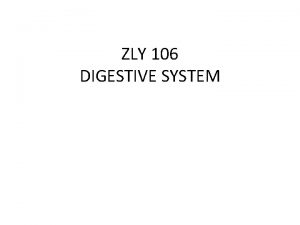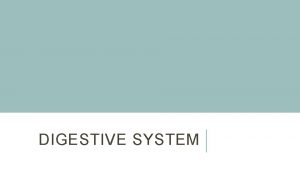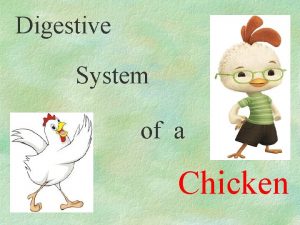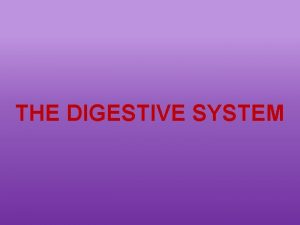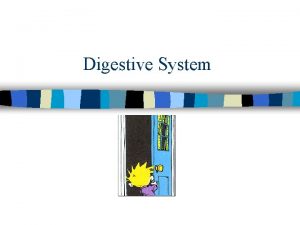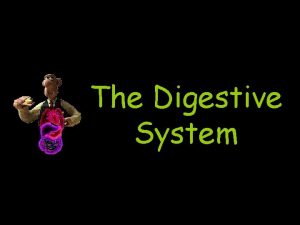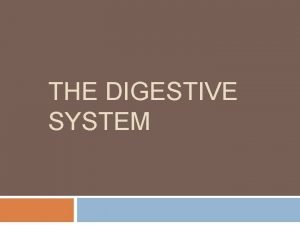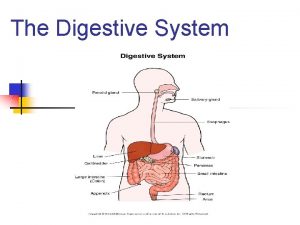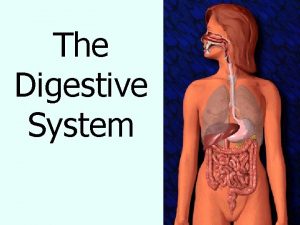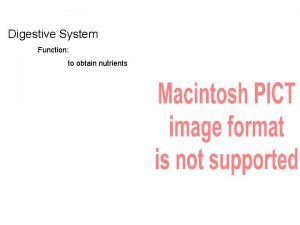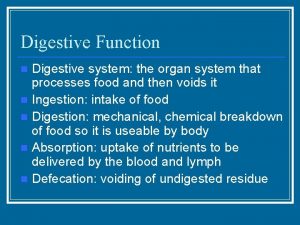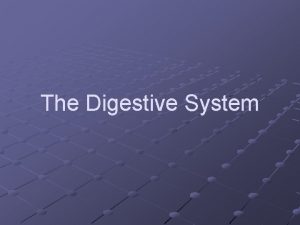Internal Systems Digestive System Digestive System Function is
































- Slides: 32

Internal Systems Digestive System

Digestive System Function: is to break food down into smaller particles that can be absorbed into the circulatory system, and excrete the remaining waste.

Digestive System The digestive system can be divided into four stages: 1. Ingestion: the taking in of food 2. Digestion: the breakdown of complex molecules into smaller ones. 3. Absorption: the transport of digested food molecules into the circulatory system 4. Elimination: the removal of undigested food from the body

Digestive System Structure • This process is completed by the digestive tract (GI tract) which is 6. 5 – 9 metres long and open at both ends. • It is a closed system made up of the digestive tract and accessory organs • It takes approximately 24 -33 hours for each meal to complete the journey through the digestive tract.

Digestive System In humans, the digstive tract contains the mouth, esophagus, stomach, small intestine, large intestine, and the anus. Accessory organs – supply digestive enzymes that break up the food to make transportation and absorption of food easier. *food does not actually pass through structure!* ex. Liver, pancreas, gall bladder

Organs of the Digestive System *Remember Structure Always Matches Function 1. Mouth • Also referred to as the oral cavity. • Two types of digestion occur here. A. Mechanical Digestion – Food is physically broken down by the teeth B. Chemical Digestion – Food is chemically broken down by enzymes and water in our saliva

Oral Cavity • Teeth are specialized for particular tasks. • Snake teeth slope backward, to help them hold their prey during swallowing

Oral Cavity • In carnivores such as the dog, “canine” teeth specialized for ripping food are more common.

Oral Cavity In herbivores such as deer, grinding teeth are more common.

Oral Cavity In the beaver the fore teeth are specialized as incisors – chisels.

Oral Cavity In the elephant, two of the upper front teeth are specialized as weapons.

Oral Cavity Humans are omnivores – we consume both plant and animal food – and have a wide variety of teeth containing canine, chisel, and grinding teeth.

Oral Cavity • Types of Teeth – locate and determine the function for each – Molars – Premolars (bicuspids) – Canines – Incisors

Oral Cavity • Incisors – for biting, cutting • Canines – tearing • Premolars – grinding • Molars - crushing

Oral Cavity – Chemical Digestion • Salivary glands secrete saliva. – Why? – What is in saliva? – What triggers it? When is it produced in mouth? • Saliva is made up of water, mucous, amylase (enzyme that breaks down carbohydrates into glucose) – Enzymes act as chemical scissors to speed up digestion

How does food move through body? • Tongue – moves food around to speed physical and chemical digestion, while forming a bolus (small ball of food) that can be swallowed. • Epiglottis – flap-like structure that covers the opening of the trachea so that food enters the digestive tract, instead of the lungs • Peristalsis – Waves of strong muscle contractions that push food along the digestive tract. Ex. toothpaste

Learning Check • Identify the skulls around the room • Page 325 #1 -4 • Copy Figure 10. 4 on page 326 to help explain peristalsis • Page 327 #5 -6

Digestive System 2. Esophagus • A long tube with 2 layers of muscles. • One layer is circular and the other is longitudinal. • These layers contract and relax creating a wave-like motion called peristalsis which moves food down to the stomach. • You. Tube - How the Body Works : The Alimentary Canal

3. Stomach • • Rings of muscle called sphincters are found at both ends of the stomach and they control when food enters and leaves the stomach. Stomach has 2 functions: 1. Storage of food 2. Chemical and physical digestion

3. Stomach • The stomach has 3 layers of muscles arranged in a circular, longitudinal, and oblique pattern. • Folds in the stomach wall called ruggae allow the stomach to expand so it can store up to 1. 5 L of food.

3. Stomach • Gastric juices are secreted and consist of 3 substances: 1. Hydrochloric acid which kills bacteria and makes an acidic environment for enzymes 2. Mucus which protects the lining of stomach 3. Pepsin, an enzyme which breaks down protein • Some substances such as water, sugar, ions and alcohol can be absorbed through the stomach lining. • Chyme is the name given to the contents of the stomach (made up of water, gastric juices and partially digested food.

3. Stomach

4. Small Intestine • Total length of 7 m and diameter of 2. 5 cm • Divided into 3 parts 1. Duodenum: where majority of digestion takes place 2. Jejunum: where digestion and absorption take place 3. Ileum: where some digestion and mostly absorption take place • Enzymes from the pancreas and bile from the liver aid in the digestion process.

4. Small Intestine • Along the folds of the small intestine are small finger -like projections called villi. The villi in turn have fine brush-like projections that are called microvilli. They both function to increase the surface area for the maximum absorption of nutrients through the lining of SI (ex. Diffusion).

Small Intestine • Blood vessels absorb proteins, carbohydrates, nutrients, minerals to deliver to the cells • Lymph vessels (part of the Lymphatic system) absorb fats to deliver to the cells. • Why?

5. Large Intestine • Total length of 1. 5 m and diameter of 7. 6 cm • Chemical digestion is complete by the time food enters here. • Consists of the caecum, colon, and rectum • The caecum is the blind end of the large intestine and here the appendix is located. The appendix has no know role digestion but could play some role in fighting infection.

5. Large Intestine • The most important function of the large intestine is to remove water from wastes. • Bacteria present here (such as E. coli) also make vitamins from the waste materials. • The damp mass of indigestible material that remains is called feces. • Feces are stored in the rectum and when nerves send impulses to the walls of the rectum a bowel movement occurs. The feces are expelled through the anus. This opening is controlled by another sphincter called the anal sphincter.

5. Large Intestine

6. Liver • Produces a fluid called bile. Bile contains bile salts which speed up the digestion of fats by breaking them down into little droplets. When bile is not secreted into the small intestine directly, it is stored in the gall bladder. • The liver also detoxifies harmful substances in the body, breaks down old red blood cells, and stores substances such as vitamins and glycogen (form of carbohydrates).

7. Pancreas • Produces the following digestive secretions: 1. Neutralizer which neutralizes acidic chyme entering the small intestine. 2. Protein digesting enzyme such as trypsin 3. Fat digesting enzyme such as lipase 4. Carbohydrate digesting enzyme such as amylase

Digestion and Homeostasis • The digestive system interacts with all human body systems to supply nutrients!

Learning Check • • • Page 327 #7 Page 328 #8 -10 Page 330 #11 -12 Review questions page 331 Use classroom models, make flashcards, summary tables to organize information
 Digestive system circulatory system and respiratory system
Digestive system circulatory system and respiratory system Pepto bysmol
Pepto bysmol Figure 14-1 digestive system
Figure 14-1 digestive system Digestive system function
Digestive system function Function of digestive system
Function of digestive system Function of cecum in digestive system
Function of cecum in digestive system Major function of digestive system
Major function of digestive system Common bile duct empties into
Common bile duct empties into Large intestine function in digestive system
Large intestine function in digestive system Pharynx digestion
Pharynx digestion Mechanism of digestive system
Mechanism of digestive system Large intestine function in digestive system
Large intestine function in digestive system 4 functions of the digestive system
4 functions of the digestive system Large intestine function in digestive system
Large intestine function in digestive system What is the j shaped muscular bag
What is the j shaped muscular bag Difference between internal check and internal control
Difference between internal check and internal control Audit report of a company
Audit report of a company Questions on digestive system
Questions on digestive system Nervous system and digestive system
Nervous system and digestive system Judi addelston obituary
Judi addelston obituary Costal muscles
Costal muscles Function of internal intercostal muscles
Function of internal intercostal muscles Chapter 9 managing the internal audit function
Chapter 9 managing the internal audit function Eustachian tubes frog
Eustachian tubes frog Chapter 9 managing the internal audit function
Chapter 9 managing the internal audit function Vibrational partition function
Vibrational partition function Gibbs free energy
Gibbs free energy Decision support systems and intelligent systems
Decision support systems and intelligent systems Principles of complex systems for systems engineering
Principles of complex systems for systems engineering Embedded systems vs cyber physical systems
Embedded systems vs cyber physical systems Elegant systems
Elegant systems Goat digestive system
Goat digestive system Monogastric system
Monogastric system

